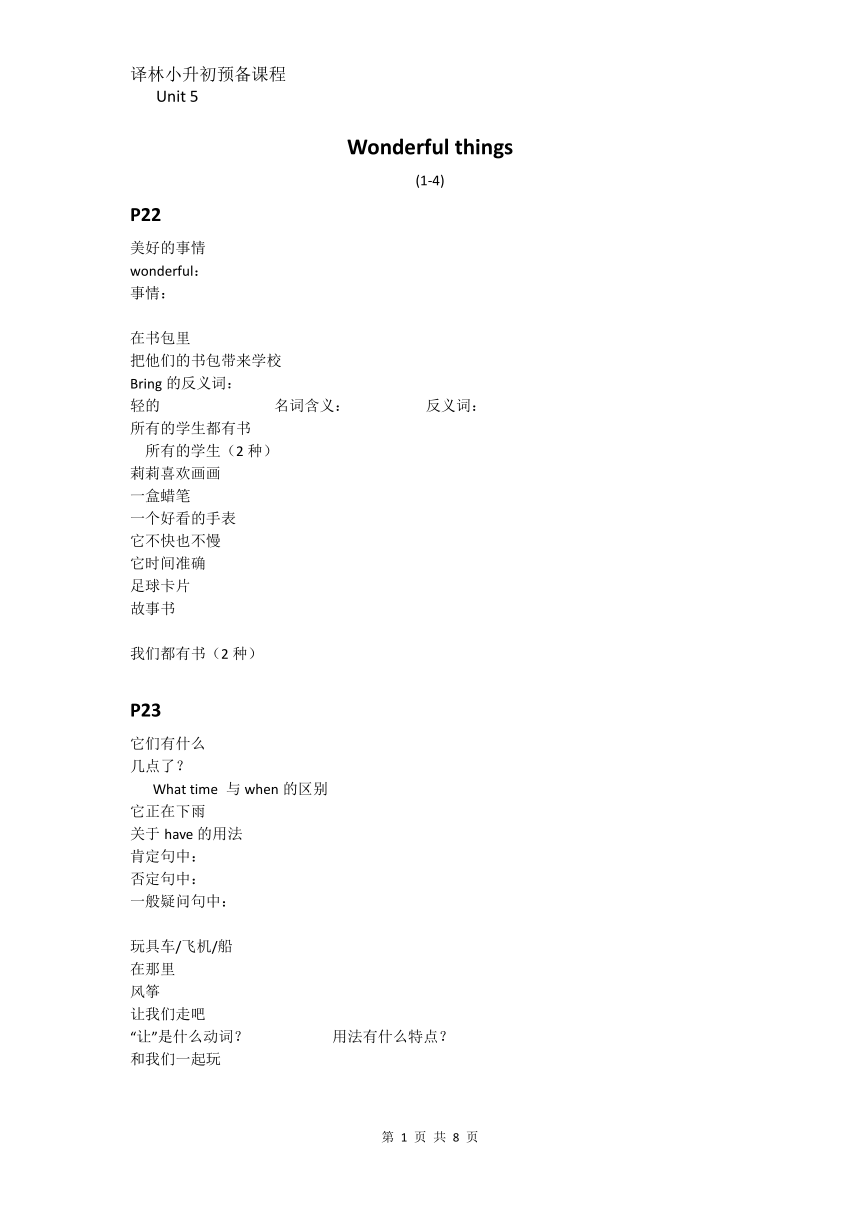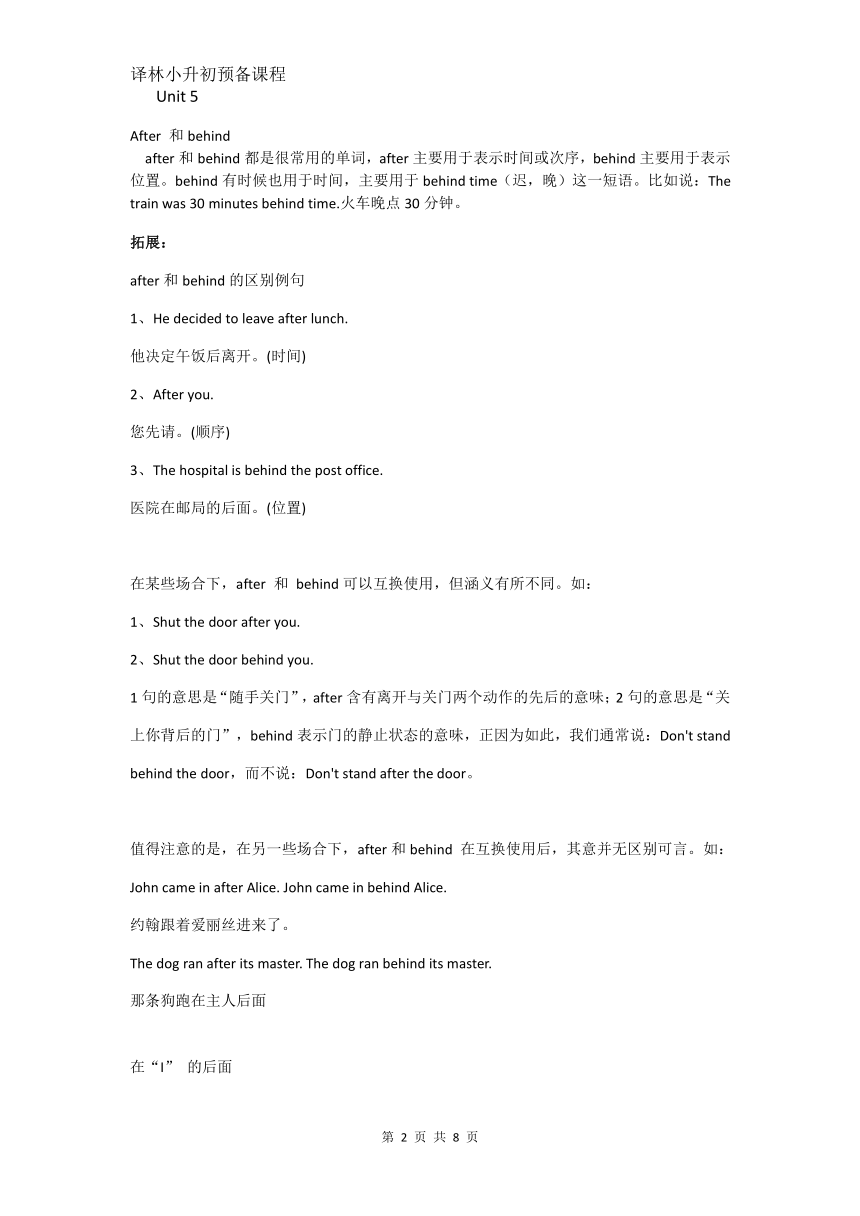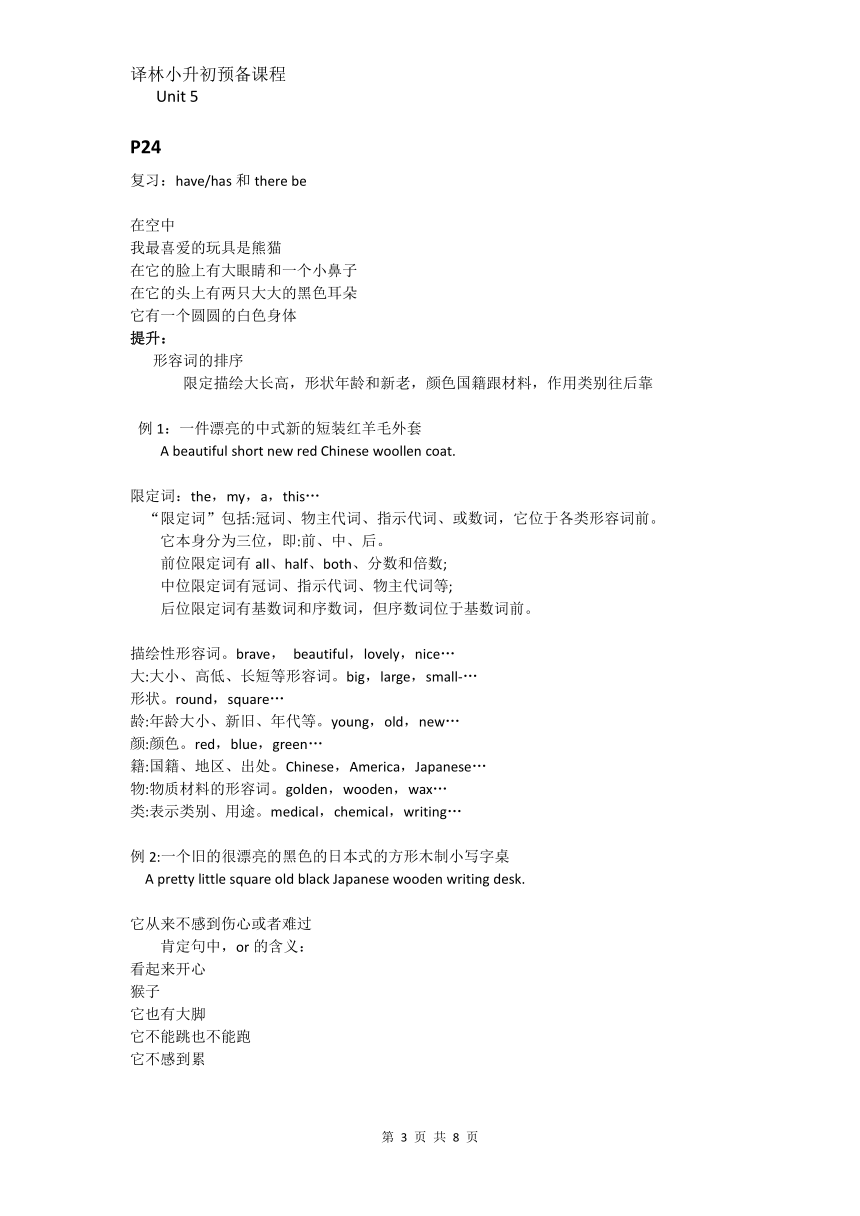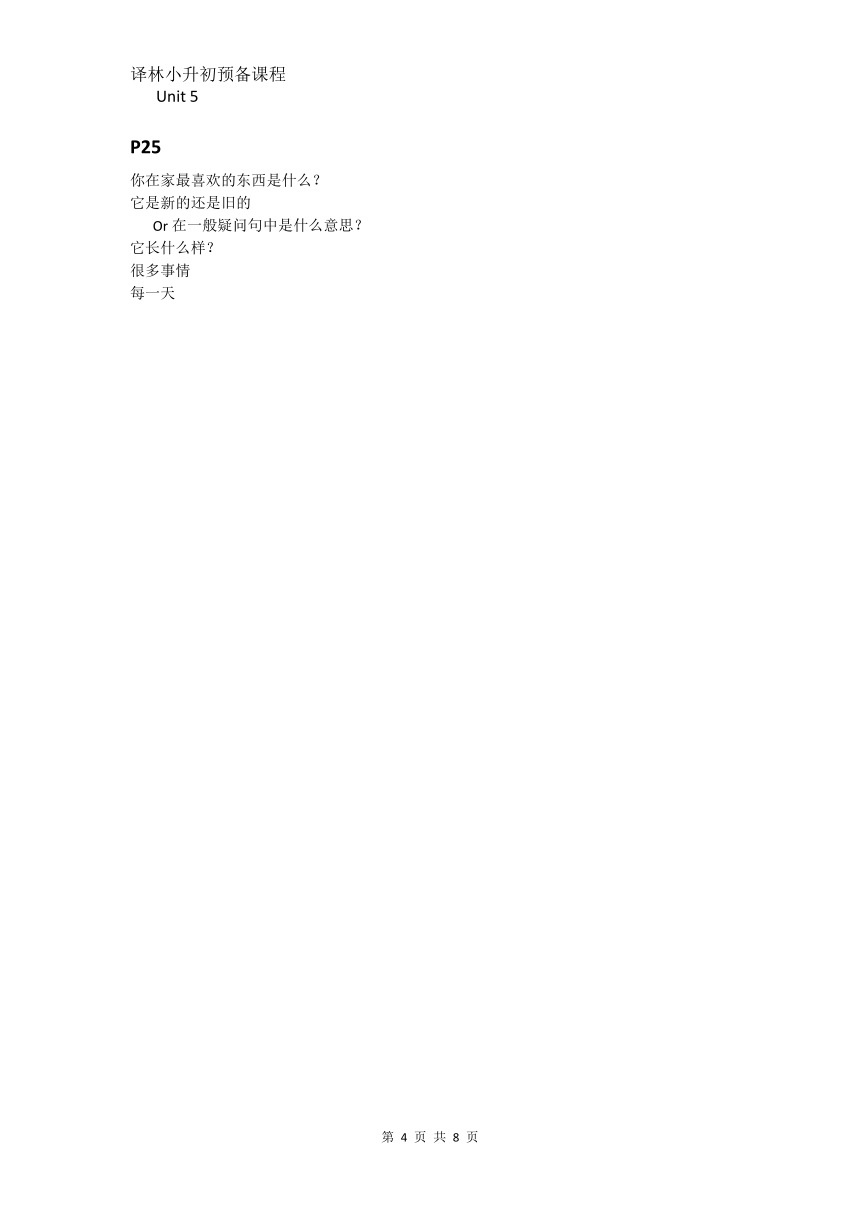2021年牛津译林小升初预备课程 Lesson 5 Wonderful things学案
文档属性
| 名称 | 2021年牛津译林小升初预备课程 Lesson 5 Wonderful things学案 |  | |
| 格式 | doc | ||
| 文件大小 | 28.5KB | ||
| 资源类型 | 教案 | ||
| 版本资源 | 牛津译林版 | ||
| 科目 | 英语 | ||
| 更新时间 | 2021-07-13 10:56:39 | ||
图片预览




文档简介
译林小升初预备课程
Unit 5
Wonderful things
(1-4)
P22
美好的事情
wonderful:
事情:
在书包里
把他们的书包带来学校
Bring的反义词:
轻的 名词含义: 反义词:
所有的学生都有书
所有的学生(2种)
莉莉喜欢画画
一盒蜡笔
一个好看的手表
它不快也不慢
它时间准确
足球卡片
故事书
我们都有书(2种)
P23
它们有什么
几点了?
What time 与when的区别
它正在下雨
关于have的用法
肯定句中:
否定句中:
一般疑问句中:
玩具车/飞机/船
在那里
风筝
让我们走吧
“让”是什么动词? 用法有什么特点?
和我们一起玩
After 和behind
after和behind都是很常用的单词,after主要用于表示时间或次序,behind主要用于表示位置。behind有时候也用于时间,主要用于behind time(迟,晚)这一短语。比如说:The train was 30 minutes behind time.火车晚点30分钟。
拓展:
after和behind的区别例句
1、He decided to leave after lunch.
他决定午饭后离开。(时间)
2、After you.
您先请。(顺序)
3、The hospital is behind the post office.
医院在邮局的后面。(位置)
在某些场合下,after 和 behind可以互换使用,但涵义有所不同。如:
1、Shut the door after you.
2、Shut the door behind you.
1句的意思是“随手关门”,after含有离开与关门两个动作的先后的意味;2句的意思是“关上你背后的门”,behind表示门的静止状态的意味,正因为如此,我们通常说:Don't stand behind the door,而不说:Don't stand after the door。
值得注意的是,在另一些场合下,after和behind 在互换使用后,其意并无区别可言。如:
John came in after Alice. John came in behind Alice.
约翰跟着爱丽丝进来了。
The dog ran after its master. The dog ran behind its master.
那条狗跑在主人后面
在“I” 的后面
P24
复习:have/has和there be
在空中
我最喜爱的玩具是熊猫
在它的脸上有大眼睛和一个小鼻子
在它的头上有两只大大的黑色耳朵
它有一个圆圆的白色身体
提升:
形容词的排序
限定描绘大长高,形状年龄和新老,颜色国籍跟材料,作用类别往后靠
例1:一件漂亮的中式新的短装红羊毛外套
A beautiful short new red Chinese woollen coat.
限定词:the,my,a,this…
“限定词”包括:冠词、物主代词、指示代词、或数词,它位于各类形容词前。
它本身分为三位,即:前、中、后。
前位限定词有all、half、both、分数和倍数;
中位限定词有冠词、指示代词、物主代词等;
后位限定词有基数词和序数词,但序数词位于基数词前。
描绘性形容词。brave, beautiful,lovely,nice…
大:大小、高低、长短等形容词。big,large,small-…
形状。round,square…
龄:年龄大小、新旧、年代等。young,old,new…
颜:颜色。red,blue,green…
籍:国籍、地区、出处。Chinese,America,Japanese…
物:物质材料的形容词。golden,wooden,wax…
类:表示类别、用途。medical,chemical,writing…
例2:一个旧的很漂亮的黑色的日本式的方形木制小写字桌
A pretty little square old black Japanese wooden writing desk.
它从来不感到伤心或者难过
肯定句中,or的含义:
看起来开心
猴子
它也有大脚
它不能跳也不能跑
它不感到累
P25
你在家最喜欢的东西是什么?
它是新的还是旧的
Or在一般疑问句中是什么意思?
它长什么样?
很多事情
每一天
Wonderful things答案
(5-8)
P22
美好的事情 wonderful things
wonderful:奇妙的、极好的
事情:thing
在书包里 in the schoolbag
把他们的书包带来学校 bring their schoolbag to school
Bring的反义词:take
轻的 light 名词含义: 灯 反义词:heavy
所有的学生都有书 all of the students have books
所有的学生(2种)all of the students; all the students
莉莉喜欢画画 Lily likes drawing
一盒蜡笔 a box of crayon
一个好看的手表 a nice watch
它不快也不慢 it is not fast or slow
它时间准确 it tells right time
足球卡片 football cards
故事书 storybook
我们都有书(2种)we all have books; all of us have books
P23
它们有什么 what do they have ?
几点了?What time is it?
What time 与when的区别:what time只可以对钟点提问
它正在下雨 it is raining
关于have的用法
肯定句中:要注意have/has的区别
否定句中:借助助动词的否定don’t/doesn’t, 注意have只能用原形
疑问句中:借助助动词的否定don’t/doesn’t, 注意have只能用原形
玩具车/飞机/船 toy car/plane/ship
在那里 over there
风筝 kite
让我们走吧 let’s go
“让”是什么动词? 使役动词 用法有什么特点?后面+动原
和他们一起玩 play with them
After 和behind
after和behind都是很常用的单词,after主要用于表示时间或次序,behind主要用于表示位置。behind有时候也用于时间,主要用于behind time(迟,晚)这一短语。比如说:The train was 30 minutes behind time.火车晚点30分钟。
拓展:
after和behind的区别例句
1、He decided to leave after lunch.
他决定午饭后离开。(时间)
2、After you.
您先请。(顺序)
3、The hospital is behind the post office.
医院在邮局的后面。(位置)
在某些场合下,after 和 behind可以互换使用,但涵义有所不同。如:
1、Shut the door after you.
2、Shut the door behind you.
1句的意思是“随手关门”,after含有离开与关门两个动作的先后的意味;2句的意思是“关上你背后的门”,behind表示门的静止状态的意味,正因为如此,我们通常说:Don't stand behind the door,而不说:Don't stand after the door。
值得注意的是,在另一些场合下,after和behind 在互换使用后,其意并无区别可言。如:
John came in after Alice. John came in behind Alice.
约翰跟着爱丽丝进来了。
The dog ran after its master. The dog ran behind its master.
那条狗跑在主人后面
在“I” 的后面 after I
P24
复习:have/has和there be
见前面单元
在空中 in the sky
我最喜爱的玩具是熊猫 my favorite toy is panda
在它的脸上有大眼睛和一个小鼻子 it has big eyes and a small nose on its face
在它的头上有两只黑色耳朵 it has two black ears on its head
它有一个圆圆的白色身体 it has a round white body
提升:
形容词的排序
限定描绘大长高,形状年龄和新老,颜色国籍跟材料,作用类别往后靠
例1:一件漂亮的中式新的短装红羊毛外套
A beautiful short new red Chinese woollen coat.
限定词:the,my,a,this…
“限定词”包括:冠词、物主代词、指示代词、或数词,它位于各类形容词前。
它本身分为三位,即:前、中、后。
前位限定词有all、half、both、分数和倍数;
中位限定词有冠词、指示代词、物主代词等;
后位限定词有基数词和序数词,但序数词位于基数词前。
描绘性形容词。brave, beautiful,lovely,nice…
大:大小、高低、长短等形容词。big,large,small…
形状。round,square…
龄:年龄大小、新旧、年代等。young,old,new…
颜:颜色。red,blue,green…
籍:国籍、地区、出处。Chinese,America,Japanese…
物:物质材料的形容词。golden,wooden,wax…
类:表示类别、用途。medical,chemical,writing…
例2:一个旧的很漂亮的黑色的日本式的方形木制小写字桌
A pretty little square old black Japanese wooden writing desk.
它从来不感到伤心或者生气 it never feel sad or angry
肯定句中,or的含义: 或者(表其中之一)
看起来开心 look happy
猴子 monkey
它也有大脚 it has big feet too
它不能跳也不能跑 it cannot jump or run
它从不感到累 it never feel tired
P25
你在家最喜欢的东西是什么? what’s your favorite thing at home?
它是新的还是旧的? is it new or old?
Or在一般疑问句中是什么意思?还是
它长什么样? what’s it like?
很多事情 many things
每一天 every day
Unit 5
Wonderful things
(1-4)
P22
美好的事情
wonderful:
事情:
在书包里
把他们的书包带来学校
Bring的反义词:
轻的 名词含义: 反义词:
所有的学生都有书
所有的学生(2种)
莉莉喜欢画画
一盒蜡笔
一个好看的手表
它不快也不慢
它时间准确
足球卡片
故事书
我们都有书(2种)
P23
它们有什么
几点了?
What time 与when的区别
它正在下雨
关于have的用法
肯定句中:
否定句中:
一般疑问句中:
玩具车/飞机/船
在那里
风筝
让我们走吧
“让”是什么动词? 用法有什么特点?
和我们一起玩
After 和behind
after和behind都是很常用的单词,after主要用于表示时间或次序,behind主要用于表示位置。behind有时候也用于时间,主要用于behind time(迟,晚)这一短语。比如说:The train was 30 minutes behind time.火车晚点30分钟。
拓展:
after和behind的区别例句
1、He decided to leave after lunch.
他决定午饭后离开。(时间)
2、After you.
您先请。(顺序)
3、The hospital is behind the post office.
医院在邮局的后面。(位置)
在某些场合下,after 和 behind可以互换使用,但涵义有所不同。如:
1、Shut the door after you.
2、Shut the door behind you.
1句的意思是“随手关门”,after含有离开与关门两个动作的先后的意味;2句的意思是“关上你背后的门”,behind表示门的静止状态的意味,正因为如此,我们通常说:Don't stand behind the door,而不说:Don't stand after the door。
值得注意的是,在另一些场合下,after和behind 在互换使用后,其意并无区别可言。如:
John came in after Alice. John came in behind Alice.
约翰跟着爱丽丝进来了。
The dog ran after its master. The dog ran behind its master.
那条狗跑在主人后面
在“I” 的后面
P24
复习:have/has和there be
在空中
我最喜爱的玩具是熊猫
在它的脸上有大眼睛和一个小鼻子
在它的头上有两只大大的黑色耳朵
它有一个圆圆的白色身体
提升:
形容词的排序
限定描绘大长高,形状年龄和新老,颜色国籍跟材料,作用类别往后靠
例1:一件漂亮的中式新的短装红羊毛外套
A beautiful short new red Chinese woollen coat.
限定词:the,my,a,this…
“限定词”包括:冠词、物主代词、指示代词、或数词,它位于各类形容词前。
它本身分为三位,即:前、中、后。
前位限定词有all、half、both、分数和倍数;
中位限定词有冠词、指示代词、物主代词等;
后位限定词有基数词和序数词,但序数词位于基数词前。
描绘性形容词。brave, beautiful,lovely,nice…
大:大小、高低、长短等形容词。big,large,small-…
形状。round,square…
龄:年龄大小、新旧、年代等。young,old,new…
颜:颜色。red,blue,green…
籍:国籍、地区、出处。Chinese,America,Japanese…
物:物质材料的形容词。golden,wooden,wax…
类:表示类别、用途。medical,chemical,writing…
例2:一个旧的很漂亮的黑色的日本式的方形木制小写字桌
A pretty little square old black Japanese wooden writing desk.
它从来不感到伤心或者难过
肯定句中,or的含义:
看起来开心
猴子
它也有大脚
它不能跳也不能跑
它不感到累
P25
你在家最喜欢的东西是什么?
它是新的还是旧的
Or在一般疑问句中是什么意思?
它长什么样?
很多事情
每一天
Wonderful things答案
(5-8)
P22
美好的事情 wonderful things
wonderful:奇妙的、极好的
事情:thing
在书包里 in the schoolbag
把他们的书包带来学校 bring their schoolbag to school
Bring的反义词:take
轻的 light 名词含义: 灯 反义词:heavy
所有的学生都有书 all of the students have books
所有的学生(2种)all of the students; all the students
莉莉喜欢画画 Lily likes drawing
一盒蜡笔 a box of crayon
一个好看的手表 a nice watch
它不快也不慢 it is not fast or slow
它时间准确 it tells right time
足球卡片 football cards
故事书 storybook
我们都有书(2种)we all have books; all of us have books
P23
它们有什么 what do they have ?
几点了?What time is it?
What time 与when的区别:what time只可以对钟点提问
它正在下雨 it is raining
关于have的用法
肯定句中:要注意have/has的区别
否定句中:借助助动词的否定don’t/doesn’t, 注意have只能用原形
疑问句中:借助助动词的否定don’t/doesn’t, 注意have只能用原形
玩具车/飞机/船 toy car/plane/ship
在那里 over there
风筝 kite
让我们走吧 let’s go
“让”是什么动词? 使役动词 用法有什么特点?后面+动原
和他们一起玩 play with them
After 和behind
after和behind都是很常用的单词,after主要用于表示时间或次序,behind主要用于表示位置。behind有时候也用于时间,主要用于behind time(迟,晚)这一短语。比如说:The train was 30 minutes behind time.火车晚点30分钟。
拓展:
after和behind的区别例句
1、He decided to leave after lunch.
他决定午饭后离开。(时间)
2、After you.
您先请。(顺序)
3、The hospital is behind the post office.
医院在邮局的后面。(位置)
在某些场合下,after 和 behind可以互换使用,但涵义有所不同。如:
1、Shut the door after you.
2、Shut the door behind you.
1句的意思是“随手关门”,after含有离开与关门两个动作的先后的意味;2句的意思是“关上你背后的门”,behind表示门的静止状态的意味,正因为如此,我们通常说:Don't stand behind the door,而不说:Don't stand after the door。
值得注意的是,在另一些场合下,after和behind 在互换使用后,其意并无区别可言。如:
John came in after Alice. John came in behind Alice.
约翰跟着爱丽丝进来了。
The dog ran after its master. The dog ran behind its master.
那条狗跑在主人后面
在“I” 的后面 after I
P24
复习:have/has和there be
见前面单元
在空中 in the sky
我最喜爱的玩具是熊猫 my favorite toy is panda
在它的脸上有大眼睛和一个小鼻子 it has big eyes and a small nose on its face
在它的头上有两只黑色耳朵 it has two black ears on its head
它有一个圆圆的白色身体 it has a round white body
提升:
形容词的排序
限定描绘大长高,形状年龄和新老,颜色国籍跟材料,作用类别往后靠
例1:一件漂亮的中式新的短装红羊毛外套
A beautiful short new red Chinese woollen coat.
限定词:the,my,a,this…
“限定词”包括:冠词、物主代词、指示代词、或数词,它位于各类形容词前。
它本身分为三位,即:前、中、后。
前位限定词有all、half、both、分数和倍数;
中位限定词有冠词、指示代词、物主代词等;
后位限定词有基数词和序数词,但序数词位于基数词前。
描绘性形容词。brave, beautiful,lovely,nice…
大:大小、高低、长短等形容词。big,large,small…
形状。round,square…
龄:年龄大小、新旧、年代等。young,old,new…
颜:颜色。red,blue,green…
籍:国籍、地区、出处。Chinese,America,Japanese…
物:物质材料的形容词。golden,wooden,wax…
类:表示类别、用途。medical,chemical,writing…
例2:一个旧的很漂亮的黑色的日本式的方形木制小写字桌
A pretty little square old black Japanese wooden writing desk.
它从来不感到伤心或者生气 it never feel sad or angry
肯定句中,or的含义: 或者(表其中之一)
看起来开心 look happy
猴子 monkey
它也有大脚 it has big feet too
它不能跳也不能跑 it cannot jump or run
它从不感到累 it never feel tired
P25
你在家最喜欢的东西是什么? what’s your favorite thing at home?
它是新的还是旧的? is it new or old?
Or在一般疑问句中是什么意思?还是
它长什么样? what’s it like?
很多事情 many things
每一天 every day
同课章节目录
- 预备课程
- Lesson 1 Nice to meet you !
- Lesson 2 A happy family
- Lesson 3 A nice school
- Lesson 4 You look cool !
- Lesson 5 Wonderful things
- Lesson 6 Have nice food
- Lesson 7 Enjoy our days
- Lesson 8 Let's have fun !
- Unit 1 This is me
- Unit 2 Let's play sports
- Unit 3 Welcome to our school
- Unit 4 My day
- Unit 5 Let’s celebrate
- Unit 6 Food and lifestyle
- Unit 7 Shopping
- Unit 8 Fashion
